The Dell XPS 15 9550 Review: Infinity Edge Lineup Expands
by Brett Howse on March 4, 2016 8:00 AM ESTSystem Performance
The XPS 15 is offered with three processor choices. The base model is the 35-Watt Intel Core i3-6100H, which is a dual-core Skylake chip with a 2.7 GHz frequency and 3 MB of cache. While I’m sure that it’s fine for most tasks, the base model is also lacking a discrete GPU and means you are only going to be using the integrated graphics, which in this case is the HD 530. I would expect the bulk of Dell’s sales to be the Core i5 and i7 models, which also come with the NVIDIA GeForce GTX 960M graphics card. The Core i5-6300HQ is a quad-core, 45-Watt part, that runs between 2.3 and 3.2 GHz, and it has a 6 MB cache. The top option is the Core i7-6700HQ, which includes HyperThreading (the Core i5 lacks this but the Core i3 has it) and a base frequency of 2.6 GHz with a turbo frequency of 3.5 GHz. The Core i7 is the model that was provided to us for this review.
On the memory side, this device includes two SODIMM slots which is a nice bonus for upgradability. The base offering is 8 GB of DDR4-2133, and you can buy it with 16 GB as well, or if you want to add your own DIMMs you can put 32 GB in this machine. For storage, hybrid hard drives are at the low end of the device range, but Dell ramps up to PCIe based SSDs on the higher priced models. The review unit has a PM951 Samsung drive, which is the TLC version that we’ve already seen in many notebooks this year. Read speeds are generally great, but write speeds will be among the slower PCIe SSDs thanks to the TLC.
I’ve run the XPS 15 through our standard notebook suite, along with a couple of other tests as well. All laptops in the charts below are from our Notebook Bench, and if you’d like to compare the XPS 15 to any other device we’ve tested, please check it out here. The previous generation XPS 15 9530 in the charts has the Core i7-4702HQ processor, GTX 750M GPU, 3200x1800 display, and a 91 Wh battery. The Lenovo Y700 is a device that we just reviewed and has the same CPU and GPU as the XPS 15 9550, and I thought it would be interesting to also see the XPS 13 here as well, although this is the Broadwell version we reviewed last year. This is a Core i5-5200U CPU, 3200x1800 display, and 8 GB of memory.
PCMark

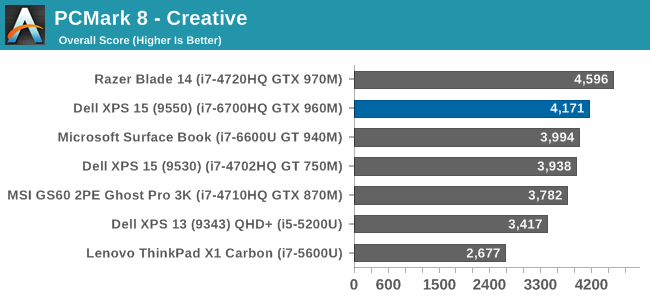
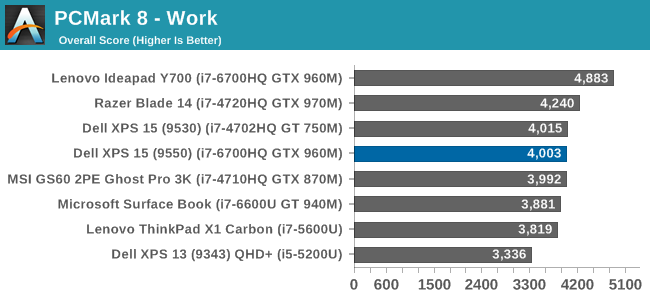
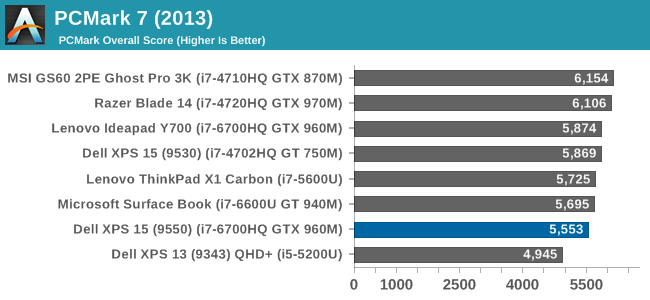
PCMark attempts to recreate actual workloads that people would use every day, and with version 8 they have several tests to focus on workloads for those tasks. Home includes web browsing, gaming, photo editing, and video chat. Creative has web browsing, photo editing, group video chat, transcoding, and some gaming, and Work has document editing, spreadsheets, and video chat. Pretty much all aspects of the device are tested, and even things like the display resolution can impact the score. The UHD resolution on the review unit impacts these scores quite a bit in fact, with the XPS 15 often quite low compared to the Lenovo Y700 which has the same CPU and GPU but a 1920x1080 display.
Cinebench
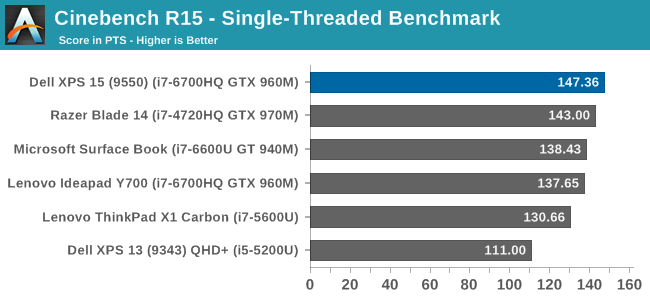
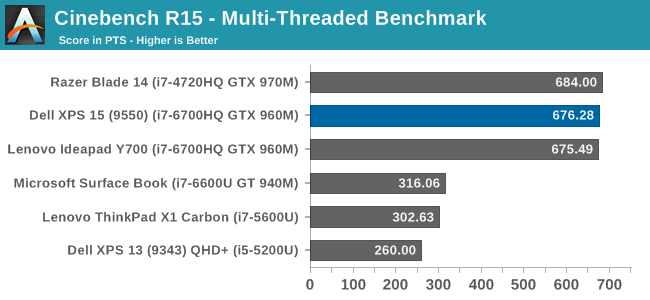
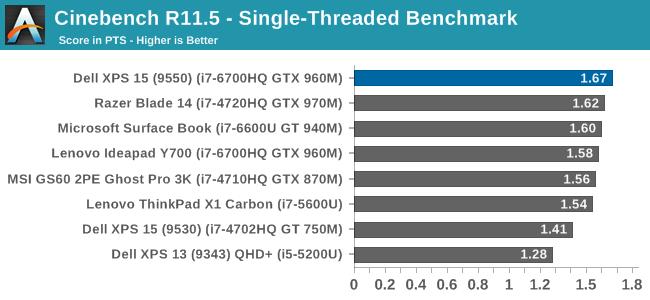
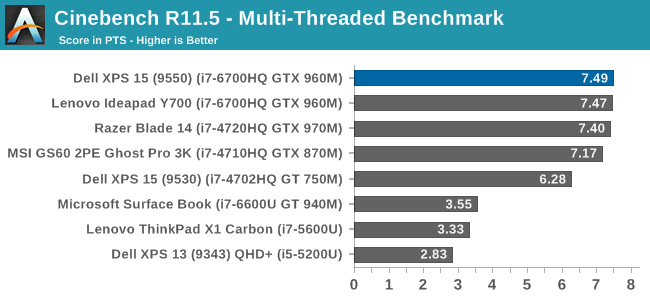
Cinebench is a CPU heavy workload which renders an image. It can use all cores and likes more MHz as well. Just like the Lenovo Y700, I found the XPS 15 wasn’t a big jump in performance with Skylake compared to Broadwell and even some of the later Haswell Core i7 parts. It is however a sizeable jump over the outgoing XPS 15 9530.
x264
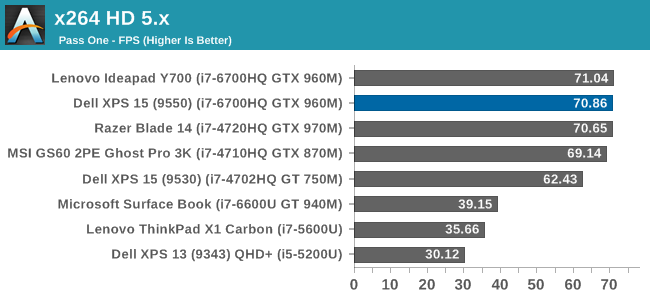
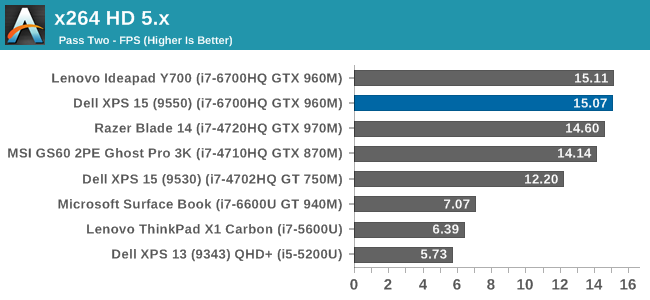
This test does video transcoding, and much like Cinebench is strongly influenced by CPU performance. More cores and higher frequencies are the name of the game here. Just like Cinebench, there also isn’t an increase in performance with Skylake on these tests compared to Broadwell or later generation Haswell chips like the i7-4720HQ, which can turbo up to 3.6 GHz compared to 3.5 GHz on the i7-6700HQ. But it is still a big jump over the i7-4702HQ found in the XPS 15 9530.
Web Tests
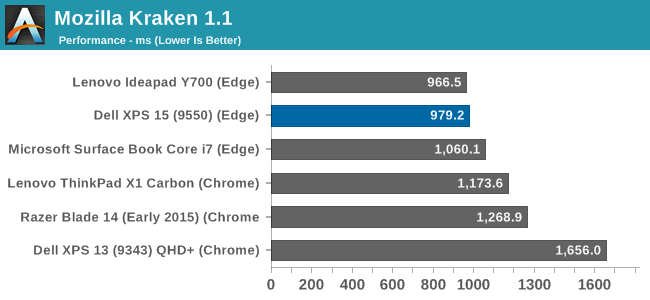
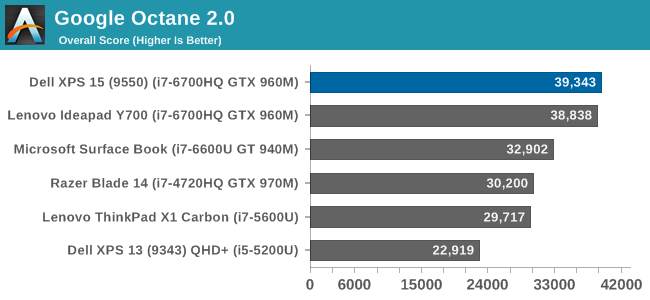
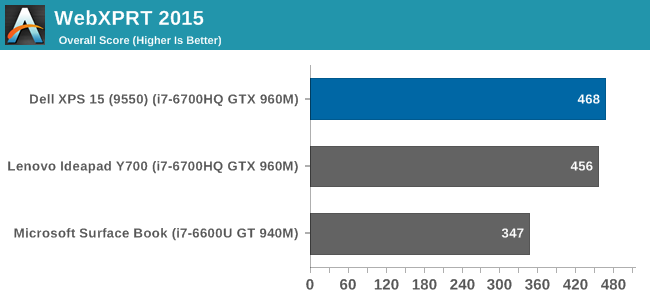
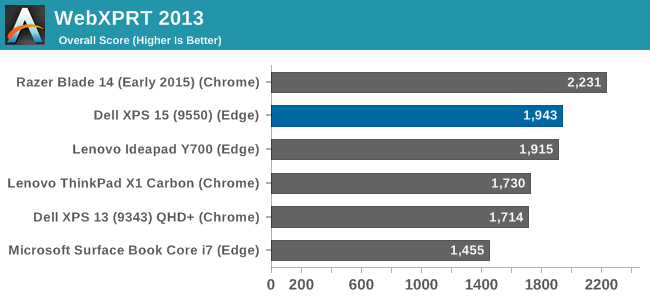
I’ve mentioned this a few times already but its worth repeating. Since the launch of Windows 10, we’ve switched from using Google Chrome for web testing to Microsoft Edge. Edge has performance that is quite a bit closer to Chrome now, surpassing it in some tests and behind in others, but both are capable browsers. As such, I’ve labeled the older laptops to let you know which browser was used at the time they were tested.
With a quad-core Skylake processor, which now supports Intel’s Speed Shift technology, the XPS 15 scores very well in our web results. The bursty nature of the web tests really plays into the hands of Speed Shift and lets the processor quickly get up to maximum frequency to perform the task, and make for a more responsive browsing experience.










152 Comments
View All Comments
milli - Friday, March 4, 2016 - link
I'm having huge stability problems with this laptop. The problem is Optimus.The only way I've gotten it to be stable, is to use the Dell provided drivers and disable Optimus.
I'm not the only one with this problem:
https://www.reddit.com/r/Dell/comments/41erin/blue...
This laptop badly needs a BIOS update to fix this issue.
smilingcrow - Friday, March 4, 2016 - link
I give leeway for photos as I know it's not easy photographing electronics at home if you have no experience but these would look bad even on eBay. Don’t recall feeling that way about any other photo shoot on any IT web review so this is a stand out.Is it too much to expect Anandtech to issue guidelines and tips for newbie photographers? I don’t think so. Amateur hour.
theduckofdeath - Saturday, March 5, 2016 - link
Hehe, that was my thoughts, too. "Dell sticks to their proven design ideas from the XPS 13" (paraphrased). Too bad we'll never know what that is.close - Monday, March 7, 2016 - link
Were you just piggy backing on a BIOS/performance related comment with a remark about photography just to get attention? I would say you give no leeway for photos which is why probably you've run out of people who's vacation photos you can criticize and ended up here :).On a related note, I wonder if the battery performance is strictly related to the choice of LCD panel. And since we're on the battery topic, I'm really impressed with the WiFi speed. It's starting to look like we're closer to moving away from wired connections completely.
milkod2001 - Monday, March 7, 2016 - link
I presume guys who write articles here are paid by amount of words/articles written and not by hours spent with camera and Photoshop.By looking at mostly poor quality of images it does not look like PURCH has given each writer a few grand for camera, lenses, accessories and guys probably just use their own crappy stuff.
Since Anand and others have left it looks like there is still big afford to write good quality articles. But other stuff coming with it goes down to hill and there is a very little improvements if any.
Just to name a few: the endless and never responded request for EDIT button for comments, some amateurish never fixed website 'features' like galleries -you click on some images, it will bring user to new tab(unnecessary) , click on some image, it will display large image and nothing else, no X or back button etc.
dsumanik - Sunday, March 6, 2016 - link
5 years ago anandtech would have tested and caught a bios issue like that, now the readers are more informed lolclose - Monday, March 7, 2016 - link
You have 3 available CPUs, 2 GPU configurations, 2 LCD panels, and different software configuration possibilities but you instantly assume that all laptops exhibit the exact same issues and they will be visible on a demo unit in the days or weeks it's available for testing.The link to the discussion about this issue includes a handful of comments and if you had the common sense to read them you would have seen that plenty of them suggest that it was fixed by using the Nvidia driver provided by Dell. Since this is a review, not a troubleshooting article I suggest you should not confuse it with a manufacturer support page.
And people could tell the difference 5 years ago.
milli - Monday, March 7, 2016 - link
No Close, all models exhibit BIOS problems. Optimus is just the latest. Before BIOS 19, there were a bunch of other issues.http://bit.ly/21gI00Z
http://bit.ly/1QZFIO8
After spending close to $3000 on a laptop, I'm very disappointed in Dell as they can't get even something like Optimus running stable.
close - Monday, March 7, 2016 - link
What I was saying was directed to the person claiming Anandtech should have reported this in the product review when clearly it doesn't affect every laptop and also I'm quite sure reviewers only have a narrow time slot to play with the device before it goes on to the next reviewer.And I maintain my suggestion for him since he appears to think such issues should be reported in a product review: the manufacturer's support site is the place to go if you're wondering how a product behaves in the long run.
Anandtech is the place to read reviews about a product, standardized tests run on every piece of hardware and some numbers that you can't find on the leaflet.
A review isn't made to showcase beautiful photos like some people seem to think (that's the job of the product marketing team) nor to listing a long line of potential issues compiled from support sites and other forums.
So I understand *you* were just cautioning potential buyers reading this review, the comment from "dsumanik" (just above) is plain ignorant to put it delicately.
dsumanik - Monday, March 7, 2016 - link
I stand by my original statement, the readers around here are now more informed than the editorial/review staff. No amount of excuse making will change this. In the past Anand (the person) worked with manufacturers on a regular basis to identify and correct issues like the one pointed out with this machine. We will never hear of a resolution to this problem on this website, unless it is in the comment section. And yes, if you are in the business of reviewing products, it IS your responsibility to investigate the issue...a simple check on the forums and a warning paragraph would have sufficed, you'd think the reviewers would haver a checklist to follow by now lol.